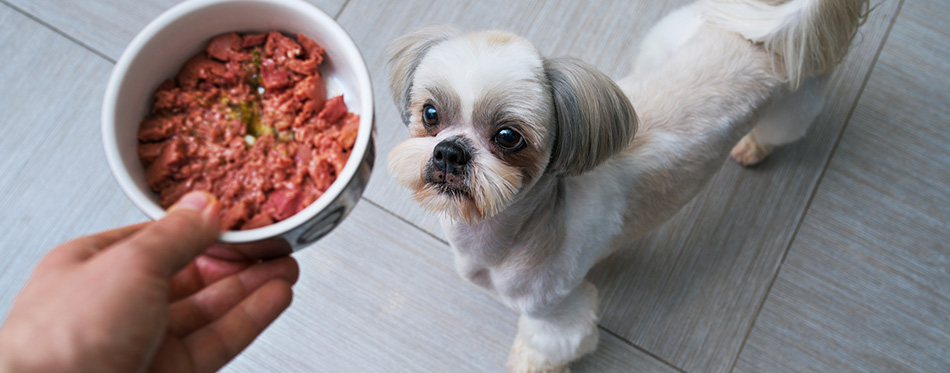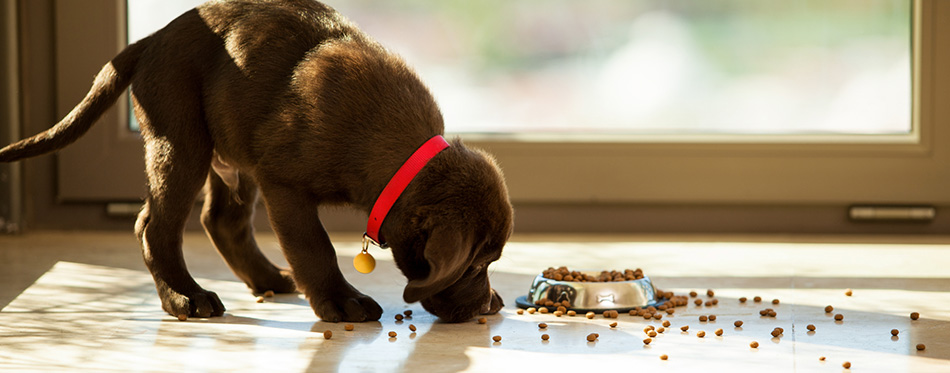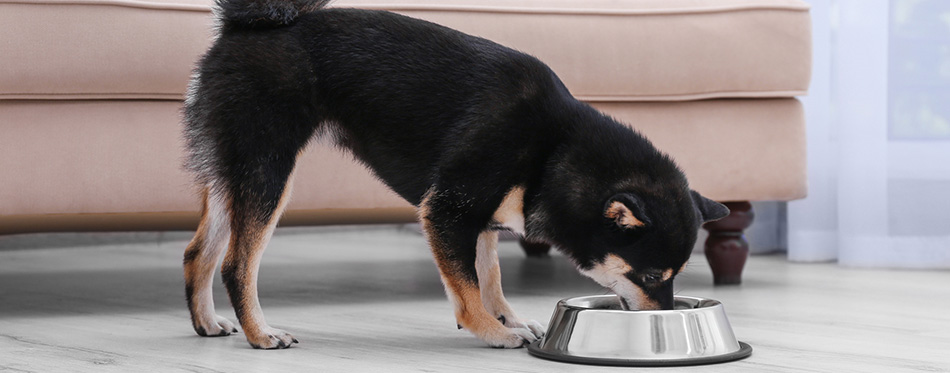Whenever we feed our pet dogs, we always look at the number of calories that they need every day. We then divide this into equal portions depending on frequent they need to feed every single day. Pet food manufacturers already provide a very handy food portion recommendation in their packaging. However, this does not take into account several factors that may have a role in the actual calorie intake of the dog. Hence, we are seeing an alarming trend whereby almost 60 percent of all dogs in the US are now either overweight or obese. It is for this reason that all pet parents should learn how to determine the actual number of calories that their dogs will need.

Factors That Can Affect a Dog’s Calorie Requirement
Calories are units of measure. In simple terms, calories are the energy that comes from food. They are the fuel that allows all living organisms to function to their fullest. When dogs eat, calories present in their food become energy. This energy fuels the different cells, tissues, and organs. In essence, it is what keeps organisms like man and dog alive.
Like humans, different dogs have different energy needs. Hence, they also have differing calorie requirements. Here are factors that can have an impact on a dog’s calorie requirement.
- Age
In general, puppies require as much as twice the amount of calories that adult dogs of the same breed need. This is on a per-pound of bodyweight. The current practice is to start feeding puppies as early as 4 weeks old. This is because the dam’s milk may no longer be sufficient to supply the nutrient and energy needs of the puppies. For more options, check out our detailed review of the best dog food for puppies.
As for geriatric dogs, they require less calories or energy than adult canines. In most cases, they need about 20 percent fewer calories to compensate for the reduction in metabolic rate and physical activity. A very important factor here is the elderly dog’s reduced ability to metabolize glucose from carbohydrates. This can lead to both obesity and diabetes. Obesity itself can exacerbate diabetes by interfering with the function of insulin, making it less sensitive to the presence of glucose in the blood. To monitor your pet’s glucose levels at home you can use glucose monitoring kits for dogs available online.
- Pregnancy / Lactation
Pregnant dogs require up to 4 to 8 times the amount of calories that healthy, non-pregnant dogs need. This is a fundamental requirement when it comes to the production of milk as well as facilitating the growth and development of the puppies inside the womb. In general, the greater the number of puppies, the greater is the amount of calories that the pregnant dog needs. It is ideal that the calories come from high-quality fats because they provide greater energy concentrations. Plus, the fatty acids that they contain are crucial for brain development in puppies.
Nursing or lactating dogs also require increased energy to help in the production of milk. It may not be as high as the energy needs of a pregnant dog, however. Like in pregnant dogs, the amount of calories that nursing dogs need is proportionate to the number of puppies that they have to feed. It can become tricky, however, since there are dog breeds that have small digestive tracts. This may not be sufficient to accommodate the amount of food necessary to produce the correct amount of calories for milk production. Hence, it may be necessary to offer supplemental feeding.
Related Post: Supplements for Pregnant Dogs
- Illness / Injury
Any injury to the dog’s body can always trigger an increase in the dog’s energy needs. Whether it is an illness or a severe injury, the different reparative processes in the dog’s body will need all the fuel they can get. Many of the dog’s cells are busy at work trying to repair the injured tissue or the sick organ. These cells require all the energy they can have. Unfortunately, only a dog nutritionist or a veterinarian can help you determine the exact amount of calories that you can give to a sick or injured dog.
- Spayed / Neutered
Neutering or spaying can cause changes in the dog’s hormonal balance. For instance, a male dog will lose testosterone while a female dog will lose estradiol. As the dog loses these hormones, there is also a change in other hormones or substances. There is an increase in leptin, which can have an impact on the dog’s appetite and food intake. Spaying or neutering also shifts the function of insulin, slowing down metabolism. Hence, spayed or neutered pets tend to have very slow metabolic rates, but with increased appetite. This can result in obesity.
Spayed or neutered pets need fewer calories than intact dogs. One can still give these dogs the standard amount of calories as their age-mates, but they have to increase their physical activity. In other words, if you do not want to change the dog’s energy consumption, then you should increase its energy expenditure.
- Size
In general, smaller breeds of dogs require more calories for every pound of body weight than their larger counterparts. The reason for this is a much higher metabolic rate among toy and small breeds. They may be small, but they often move a lot faster than larger breeds. It is also for this reason that small dog breeds need more frequent feeding than their larger brethren.
- Climate
Dogs in colder climates need as much as 2 to 3 times more calories than dogs living in moderate temperatures. In cold weather, dogs need to shiver as a means of producing body heat and keep themselves warm. Shivering requires the expenditure of energy. Dogs with thick coat and lots of fat deposits can negate the calorie-depleting effects of shivering. Even if the dog will not shiver, it will still spend energy to maintain a more stable core body temperature. A more interesting point here is the source of these dogs’ energy. Instead of sourcing it from glucose, they source it from dietary fats.
On the other hand, dogs living in warmer climates require fewer calories than those living in moderate climates. We already said that calorie is heat. The dog is already producing more than enough heat. It doesn’t need the extra heat coming from its food. As such, they will require fewer calories.
- Activity Level
Low-energy dogs are the quintessential canine couch potatoes. They prefer lying around all day long. They may move in a sluggish manner. They only require brief, short walks of no longer than 15 minutes at a time. They are not very athletic and prefer snuggling beside their owners. Hence, they require fewer calories than breeds that may have the same weight. Otherwise, you are courting canine obesity. Examples of these include the English Bulldog, the Chow Chow, and the French Bulldog, among others.
Medium-energy dogs are perfect for pet parents who lead a moderately active lifestyle. Medium-energy dogs are quiet and docile most of the time. However, when there is something that catches their attention or arouses their curiosity, these dogs can spring into action. They are famous for their short bursts of energy. These dogs are great when it comes to play activities. However, do not expect them to excel in physically demanding tasks. They need average amounts of calories. A more important consideration is the timing of the feeding. It should be as close as possible to the time when the dog is most active. The American Staffordshire Terrier, Bergamasco, Bloodhound, and Newfoundland are examples of medium-energy dog breeds.
There are canines that are full of energy that the only time you will see them resting is at night when everyone’s already asleep. High-energy dogs thrive in the most intense activities. They love to train and learn a lot of things. In fact, if you do not train them, there’s a good chance they will try to do something else. These dogs are only for people who have limitless energies, too. Otherwise, you run the risk of unleashing the destructive power of these breeds. Examples of high-energy dog breeds include the Beagle, Basenji, Border Collie, German Shepherd, and Yorkshire Terrier, among others.

The Resting Energy Requirement
In determining the number of calories that your dog needs, it is important to compute for two very important things. The first one is the Resting Energy Requirement or RER. This is the doggie equivalent to Basal Metabolic Rate or BMR in humans. What this denotes is the amount of energy that the dog needs to keep its vital organs functioning. It is the most basic energy requirement. It is what fuels the brain, heart, kidneys, lungs, liver, and other vital organs to continue working. It includes anything that is vital to the survival of the dog. Hence, it doesn’t include movement, sexuality, and other non-vital functions.
Computing for the RER is very easy. You always start with the dog’s body weight. Take note that the weight should be in kilograms. Hence, if you have your dog’s weight in pounds, then you should convert this first into kilogram by dividing it by 2.2.
Now that you have the dog’s weight in kilograms, you need to raise this value to the ¾ power. You can use your scientific calculator to compute for this value. Type the value you want to raise to ¾ power. Next, press the xy sign and then enter 0.75 for three-fourths.
Multiply the value that you obtained by 70. This will result in the dog’s Resting Energy Requirement.
Let us put this into an example.
Suppose we have a 20-lb dog. We need to convert this first to kilograms by dividing 20 by 2.2. This gives us 9.09 kilograms. Next, press “9.09” on your calculator, then the xy sign. Next, press 0.75. The operation will result in 5.235. As the last part of this process, multiply 5.235 by 70 to get 366.45. This means that our 20-lb example of a dog requires 366 to 367calories per day as its Resting Energy Requirement.
But we are not done yet. For obvious reasons, the RER only takes into consideration the vital functions of the dog. It doesn’t factor in the other activities of daily living. Hence, we also need to compute for the Maintenance Energy Requirement.
The Maintenance Energy Requirement
Compared to the RER, the Maintenance Energy Requirement denotes the actual amount of calories that a dog needs every day to be happy and healthy. This takes into consideration the dog’s need to run, walk, jump, play, bark, whine, and many other activities. In other words, the MER is a reflection of the dog’s true energy requirements every single day.
To compute for the MER, you need to multiply the RER with a predetermined “factor”. The following are some of the most common life stage factors and their corresponding values.
- Growing puppies younger than 16 weeks old = 3.0
- Growing puppies older than 16 weeks old = 2.0
- Intact or unneutered or unspayed pet = 1.8
- Neutered or spayed pet = 1.6
- To lose weight = 1.0
- To gain weight = 1.2 to 1.8
- Inactive or sedentary lifestyle = 1.2
- At-risk of obesity = 1.4
- Active with light work = 2.0
- Active with moderate work = 3.0
- Active with heavy work = 5.0
- Hospitalized or in critical care = 1.0
- Pregnancy = 1.6 to 2.0 (depending on the number of puppies)
- Lactation = 2.0 to 6.0 (depending on the number of puppies)
In the example we formulated above, we have a 20-lb dog that has an RER of 366.45 calories. Suppose this dog is neutered with normal levels of activity, then we use the “1.6” multiplier. This will give us a Maintenance Energy Requirement of 586.32 calories per day. Rounding it off, we can give such a dog about 585 to 590 calories per day.

Related Post: Dog Food for Small Dogs
It is obvious that the dog is a small breed. Hence, we need to feed it at least three times a day. This means you need to feed this dog about 195 calories per meal.
In determining the number of calories that your dog needs, you need to consider several factors. These can include the dog’s age, life stage, activity level, health status, and other factors. You can then compute for the RER and the MER to obtain the daily calorie needs of your pet.

